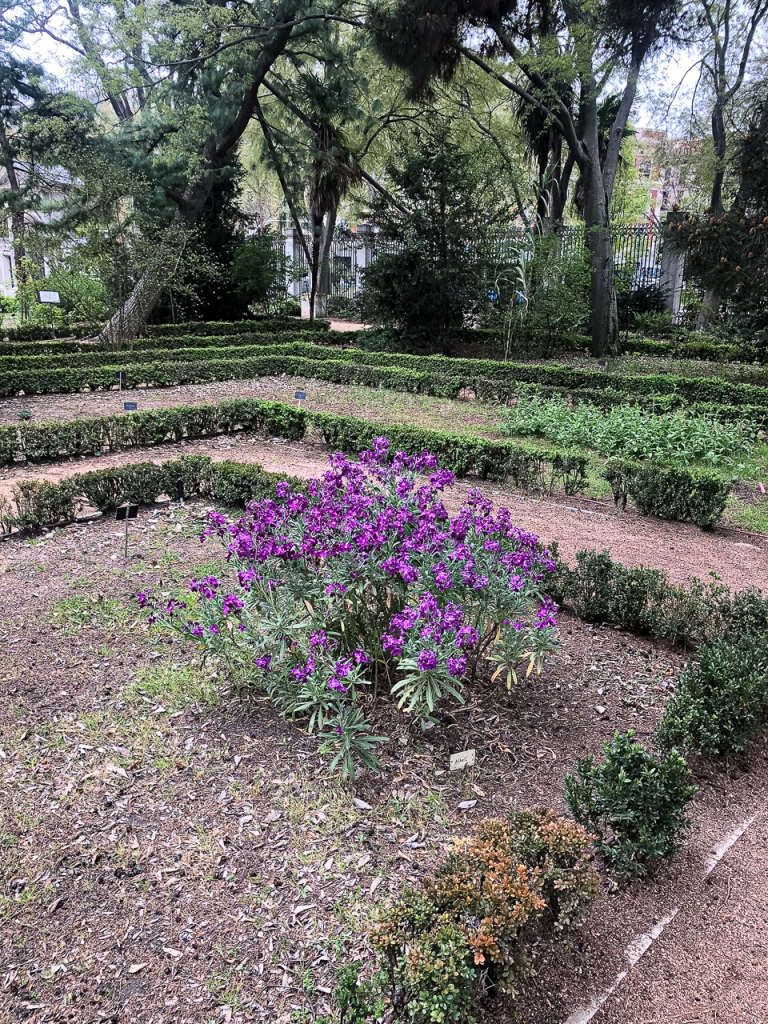Apparently, we had our one day of sun because it was once again gray when I opened the blinds. No evidence of rain though, so I guess we should be glad for small favors. Roberto, our host stopped by to collect our final payment, and we had a nice chat about the building, the rental business, Andalusia, and the apartment. After that, it was off to Santa Eulalia for coffee and to buy the New York Times.
With nothing on the agenda, we finally decided to walk down to the Prado via Calle Huertas (the nicer way down) to see if we could get into the gift shop. As always, the walks to and from pass some interesting things, in this case, a cool modern building with an older building’s facade incorporated into its structure. An interesting case of re-use and maintaining a bit of historical perspective. Of course, no trip to Paseo del Prado is complete without a stop by the renowned “garden on the side of a building.”






The sky was clearing up a bit and we decided to go to the Royal Botanical Garden, one of our favorite spots in the city and one we try not to miss on our Madrid trips.
In the 18th century, Spain was one primary centers of scientific research in Europe. Between enlightened kings and the wealth extracted from its vast colonial holdings, the country was well-positioned to provide scientists with opportunities to grow the knowledge bases in their respective fields. In 1755, King Ferdinand VI founded El Jardín Real Botánico as a repository for botanical research, and the effort was continued and increased under his son, Charles III, and his grandson, Charles IV. A series of expeditions were deployed in the late 1700s to explore the colonies with a royal charter to survey the flora of the territories, determine their economic potential, and gather collections for the Royal Botanical Garden. One expedition, led by Jose Quer y Martinez, a military surgeon, collected more than 2000 samples on various military campaigns in Europe and Africa. In 1774, Charles III ordered the garden moved to its current location, along Paseo del Prado, and the finished garden was re-opened in 1781. More than 10,000 plants were added in 1794 by Alessandro Malaspina, a Tuscan explorer and Spanish naval officer.
Abandoned in 1808 during the Spanish War of Independence, it was revived once again in 1857. Today it contains more than 90,000 plant species and 1,500 trees. In the last few years, a “sustainability garden” has been added to showcase food and medicinal plants.
We just love the place because of the peace it imparts and today our restaurant luck carried over because it turned out to be free-admission day. It’s never really crowded but even when there are other guests, it’s serene. Even the traffic noise from the busy Paseo disappears as you walk the paths. We are always here in March or April so we get to enjoy the spring Tulip gardens – a colorful gift on a gray day. Today we walked the full circuit out and back and fully re-charged we went over to the Prado and discovered that, “no,” you can’t get in the gift shop without a ticket. Judging from today’s line, we were glad we went yesterday.
On the way home we stopped at a little pizza shop that we’d patronized in the past. We had one more great conversation with the clerk about Spanish and English. We collected our food and headed back home to relax for the afternoon.





























And here’s a special bonus – my attempt at “B&W art photography.” The shrubs and their placement made me wax creative.




What a place El Jardin Real Botanico, and your pictures are only little cutouts. The B&W a special treat. Royalty makes the difference between big cities and great ones. They enabled grandeur. In the US only a Carnegie in Pittsburg came close to it.
>
Wonderful photos, it’s so beautiful. Very nice B&W